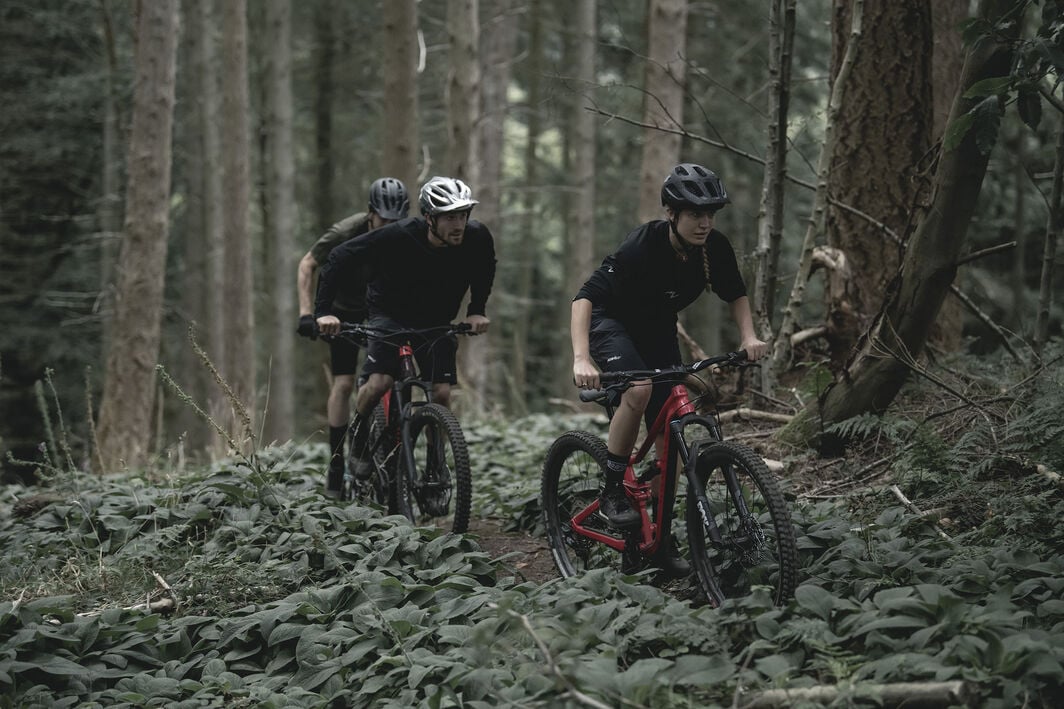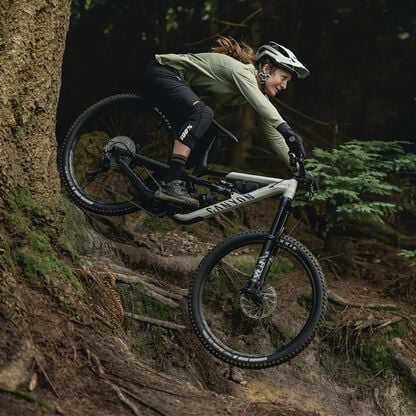Trail Mountain Bike Buyer’s Guide
A trail bike is the ultimate do-it-all machine, but which one is right for you?


Singletrack flow, XC adventure, rocky bike park trails – if a bit of everything is your type of mtb, let’s talk about the trail mountain bike.
A jack of all trades and master of many, the trail bike is the ultimate do-it-all machine, with enough travel to tackle technical trails and geometry built for comfort and confidence.
But straddling so many different types of riding style is bound to bring up questions when deciding which trail bike to buy. Can a trail bike do XC? Is 100mm travel enough for trail riding? What’s a good weight and how much does a trail bike cost?
All of this and more is answered in our Trail Bike Buyer’s Guide, so you can pick the best trail bike for you.

What is a trail mountain bike (MTB)?
A trail bike is a full suspension mountain bike that’s built for fun, flow and long days in the saddle. It’s the broadest of mountain bike categories, with 120-160mm of front travel, and up to 150mm in the rear for a mix of different terrain.
The geometry of trail bikes typically differs from enduro bikes in that trail bikes are designed to go up, down and along. You’ll find you can climb more efficiently and traverse more comfortably on a trail bike thanks to a balanced seat position.
When you start heading downwards, a trail bike still delivers smiles with confident handling. Sure, it might not be quite as at home on the steepest, roughest descents like some of the more specialist gravity bikes, but with careful line choice, you can tackle just about anything.
Depending on frame size and rider preference, trail bikes come with 27.5 inch or 29 inch wheels, a dropper seat post and wide handlebars for maximum control and manoeuvrability on the trails.
Trail bikes are a great all-rounder and a doer of all. You’ll be in for hours of fun and flow on the bike park red and blue trails, and just as comfortable on long XC rides or big mountain days, able to both descend and climb efficiently.
Sometimes called ‘all-mountain bikes’, they’re most at home on flowy singletrack, but are a bit under-biked for the black graded descents and gnarlier trails that enduro and downhill bikes will munch up with ease.
So if you’re questioning what a trail bike is used for, the answer is (nearly) everything.
Singletrack is an off-road track or trail that’s about the width of the bike, so you have to ride in single file. This is different to wider fire roads or bridleways where the path has enough room for two-way traffic, whether by bike, on foot or sometimes vehicles.
Singletrack trails twist and turn; go up and down; and can be natural trails or man-made, with rocks, roots, drops, and a whole load of mud and fun to be had. You’ll find singletrack in wooded areas, bike parks, mountain rides and hidden away in national parks.
Technically speaking, there is no difference - trail bikes are mountain bikes that are built for the trails. They have more durable and higher spec components and materials than entry level mountain bikes to withstand the technical terrain they’re so at home on.
Trail bikes bring the best of XC riding and technical trails together in one do-it-all mountain bike. They can climb and descend tough terrain efficiently, and are fun to throw around on the trails but still comfortable for big endurance rides.
Enduro bikes are a category up from trail bikes, bringing the best of downhill and trail riding together. Whilst enduro bikes can also both climb and descend, the geometry is more geared towards steeper, more technical downhill. Typically with up to 180mm front travel and 150-175mm on the rear vs 150mm on a trail bike, an enduro would feel right at home on black bike park runs, but be heavier on the climbs.

What is trail bike geometry?
The trail bike category is a broad one and sits in the middle of cross-country (XC) and enduro bikes. As such, the geometry will differ depending on which type of riding you prefer most. Some trail bikes lean more towards the XC end of the spectrum, with less travel, bigger wheels and lighter frames; and others more suited to bouncy flow and steeper, more technical descents.
Trail bikes typically have 120mm - 160mm front travel and up to 150mm on the back, with the shorter models more tailored towards faster XC riding. Trail bikes with longer travel have slightly slacker head angles than their XC-leaning counterparts to better handle technical terrain and more downhill trails.
But as with any singletrack riding, what goes down, must also ride up comfortably, so trail bike geometry offers the best of both worlds, with steeper seat tube angles than enduro bikes for optimum rider position to still power up the climbs before flying back down again.

What is a good trail bike for beginners?
If you’re just starting out with trail bike riding, the Grand Canyon is a great hardtail mountain bike designed to improve your ability and increase your confidence.
The Canyon Neuron is a great starting point for your first full suspension mountain bike. The 130mm front and rear suspension will have you gliding over rocky singletrack and sailing around corners with new-found traction.
Deciding between a XC vs trail bike comes down to the type of riding you’ll do the most. If you’re into big hill and mountain rides and get your kicks out of powering up the climbs, a lighter, faster XC hardtail or full suspension bike with short front travel would lap it up.
It’s also worth thinking about if you want to get into XC racing, as you might find a full suspension trail bike sluggish on the climbs and lose energy bouncing around.
But if you’re more interested in hitting the bike parks and seeking out hidden singletrack for fun and flow, still capable of a long XC ride, then a longer travel trail bike is for you.
The versatility of trail bike geometry means it can do XC as well as flowy singletrack. The steeper head and seat tube angles of a trail bike (whichever end of the spectrum), makes it more than capable of XC riding than its bigger enduro and downhill siblings, but not as fast or efficient as a lighter, faster XC bike.
Trail bikes with longer travel will be heavier on the climbs so choose your best trail bike depending on the type of riding you’ll do the most, whether big days in the hills, or singletrack flow. If you’re somewhere in between, a bike with around 120mm front and back will munch up whatever you throw at it.
The question of how much travel for a trail bike is a common one. Bikes with 100mm travel are typically more geared towards XC racing and endurance so may not be as comfortable on flowy technical trails. Whilst bigger wheels will help to soak up some of the impact when rolling over obstacles, you might find the suspension bottoming out on the rockier stuff.
So if you’re looking for maximum control, comfort and – let’s face it, fun – when hitting the technical trails, go for 120mm upwards.

How to choose a trail bike
With so many different options on the market, choosing the best trail bike can be a big job. The key is to think about the type of mountain biking you do the most and choose your bike based on the geometry and riding style it’s tailored for.
How much a good trail bike costs depends on the quality and durability of the components and materials it’s made from. Whilst there are some premium models available, if you’re just starting out there are plenty of good value trail bikes for sale without the hefty price tag – and you can always upgrade components later on.
Most trail bikes typically weigh between 12-14kg depending on if they’re made from carbon or aluminium. They’ve got to be sturdy enough to manoeuvre techy trails but light enough to climb efficiently. The further you go up the scale towards enduro and downhill bikes, the heavier they get.
Which trail bike should I buy?
Whichever end of the spectrum you’re leaning towards, our hugely versatile full suspension trail bikes can do it all, from quick post-work blasts to epic mountain adventures.
Best for beginners: this hardtail mountain bike is a great entry-level trail bike designed to increase your confidence. It’s easy to maintain, great fun and a perfect first mountain bike for budding mountain bikers.
Canyon Grand Canyon
This is your ticket to adventure—a versatile and capable aluminium hardtail bike that takes you anywhere you want to go. Fast flow trails or weekend mountain excursions, the choice is yours!
View all
Not sure where your trail bike will take you? From casual laps of your local woods to occasional bike park trips, and every steep climb and technical descent in between, the Spectral's longer 160mm of travel and progressive geometry offers huge capability.
The Spectral 125 offers riders with a passion for gravity a shorter travel trail option. Whether you think 150mm of travel is a little overkill for your local or want a new challenge on chunkier terrain, the Spectral 125's truly progressive geometry and tough but nimble chassis, makes this a bike that encourages you to attack the trails. As a more poppy, playful and quicker on the gas MTB than the full fat Spectral, the Spectral 125 is the rowdy one of the family.
Read more about how the Spectral compares to the Spectral 125.
Canyon Spectral
Meet the Spectral Family. Our trail slaying all-rounders combine playful handling and grin inducing capability. If you have just one mountain bike, better make it a Spectral.
View allA post-work rip through the woods, flowing singletrack or a multi-day mountain adventure – the Neuron is ready for whatever adventure you throw at it, with updated geometry for a great day on the trails.
Canyon Neuron
Neuron scales the steepest climbs and descends with complete control thanks to its 130 - 140mm suspension, 29” wheels (in sizes M-XL) and confidence-inspiring geometry.
View allVersatile, capable and ready for flow all day long, the Lux Trail is equipped with smart engineering and light, hassle-free suspension. Confidence-boosting geometry to tame the trails, crush the climbs and keep the smile plastered on your face from the top to the bottom and back up on your ride.
Canyon Lux Trail
Pure speed, up or down any trail or course you care to dominate. This is the Lux Trail.
View allDiscover our Mountain Bikes
Did this article help?
Thank you for your feedback
















